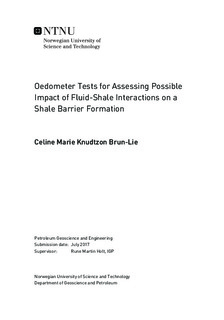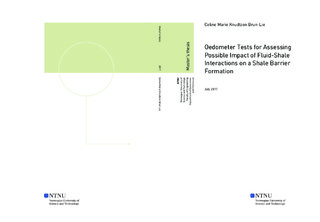| dc.contributor.advisor | Holt, Rune Martin | |
| dc.contributor.author | Brun-Lie, Celine Marie Knudtzon | |
| dc.date.accessioned | 2017-10-17T14:01:16Z | |
| dc.date.available | 2017-10-17T14:01:16Z | |
| dc.date.created | 2017-07-12 | |
| dc.date.issued | 2017 | |
| dc.identifier | ntnudaim:17963 | |
| dc.identifier.uri | http://hdl.handle.net/11250/2460620 | |
| dc.description.abstract | The focus of the research for this thesis was shale as a barrier. A hole must be permanently plugged and abandoned (PP\&A) at the end of a its lifetime. Regulations require that the annulus is properly sealed off so that no migration of hydrocarbons to the surface will occur at any time in the future. Norwegian authorities have outlined strict requirements for sealing barriers in PP\&As on the Norwegian Continental Shelf (NCS). A minimum of two independent barriers in addition to the surface/environmental barrier must be in place, requiring a full cross-sectional barrier also for the annulus. The operation is both costly and time-consuming. By using the existing technology, it has been estimated that 15 rigs will be needed for approximately 40 years of full time operation to plug and abandon existing wells on the NCS. Attention has been drawn towards sections where the annulus is not filled with cement and shale formations have moved towards the casing creating a natural barrier. Several studies have been outlined in recent years and indicates that the time-delayed deformation of the shale is most likely related to consolidation and creep.
Three triaxial loading tests with different fluids (3.5\% NaCl, 20\% KCl and fresh water) were successfully executed in order to see how the shale material behaved when axial load was applied. Different fluids were used to see if the material would behave differently when exposed to different fluids. Axial displacement, radial stress, temperature and differential pressure measurements were achieved in order to qualify and quantify the behaviour of the material. An ultrasound setup was connected to the setup to see if existing logging tools can be used in the evaluation of the natural barriers.
The major findings for this experiment showed that the shale tested creeps when exposed to NaCl, KCl and freshwater. More axial load is required to make the shale creep when exposed to NaCl and KCl than freshwater. The sample exposed to KCl shows a greater density of fractures throughout the sample than the two other samples. The permeability for each sample decreases when exposed to axial load and fluids, although the sample exposed to NaCl had a higher permeability at the end of the test than the two other tests. The ultrasound measurements confirm the results found in the triaxial tests and can be used to see if there is contact between the formation and the casing. The P-wave velocity of the sample exposed to KCl was greater than the samples exposed to NaCl and freshwater. An S-wave was likely found for two of the tests. Some elastic properties can be found through velocity analysis but the difficulty in locating an S-wave complicates the findings. | |
| dc.language | eng | |
| dc.publisher | NTNU | |
| dc.subject | Petroleumsfag, Petroleumsgeofysikk | |
| dc.title | Oedometer Tests for Assessing Possible Impact of Fluid-Shale Interactions on a Shale Barrier Formation | |
| dc.type | Master thesis | |

